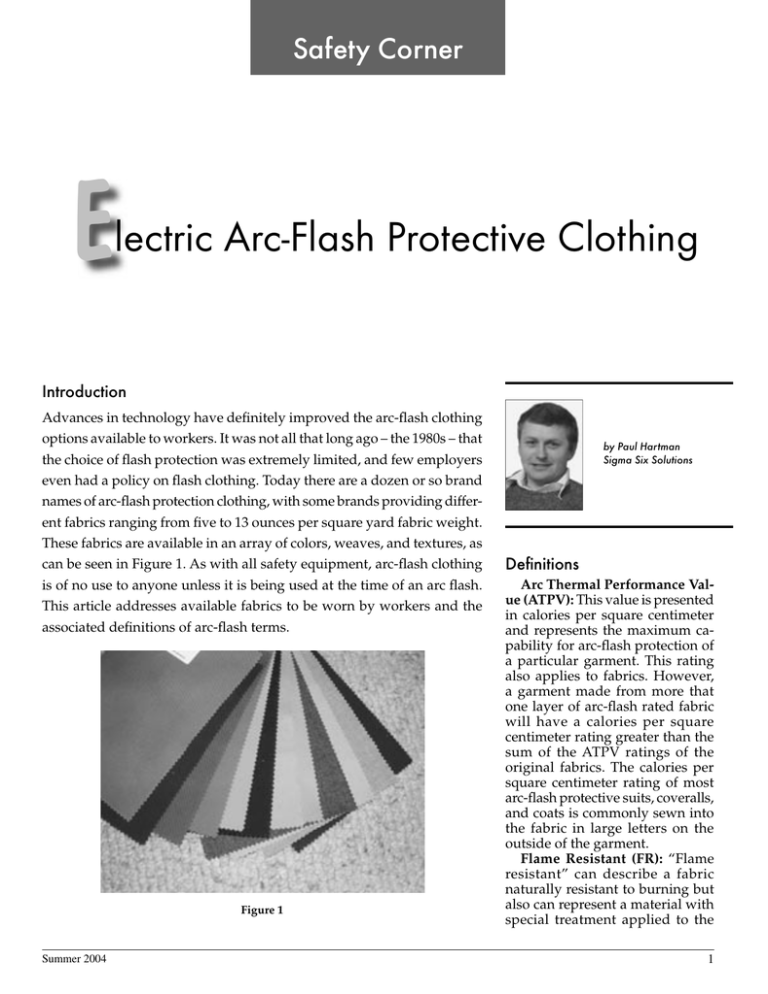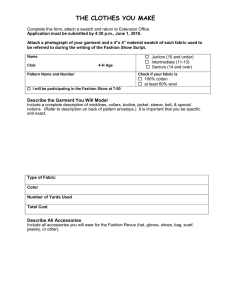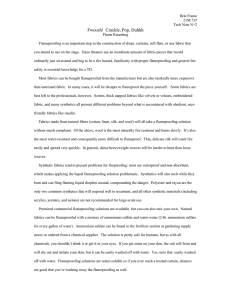Electric Arc-Flash Protective Clothing
advertisement

Safety Corner E lectric Arc-Flash Protective Clothing Introduction Advances in technology have definitely improved the arc-flash clothing options available to workers. It was not all that long ago – the 1980s – that the choice of flash protection was extremely limited, and few employers even had a policy on flash clothing. Today there are a dozen or so brand names of arc-flash protection clothing, with some brands providing different fabrics ranging from five to 13 ounces per square yard fabric weight. These fabrics are available in an array of colors, weaves, and textures, as can be seen in Figure 1. As with all safety equipment, arc-flash clothing is of no use to anyone unless it is being used at the time of an arc flash. This article addresses available fabrics to be worn by workers and the associated definitions of arc-flash terms. Figure 1 Summer 2004 by Paul Hartman Sigma Six Solutions Definitions Arc Thermal Performance Value (ATPV): This value is presented in calories per square centimeter and represents the maximum capability for arc-flash protection of a particular garment. This rating also applies to fabrics. However, a garment made from more that one layer of arc-flash rated fabric will have a calories per square centimeter rating greater than the sum of the ATPV ratings of the original fabrics. The calories per square centimeter rating of most arc-flash protective suits, coveralls, and coats is commonly sewn into the fabric in large letters on the outside of the garment. Flame Resistant (FR): “Flame resistant” can describe a fabric naturally resistant to burning but also can represent a material with special treatment applied to the 1 Hazard Risk Category (HRC): This is a 2004 NFPA 70E rating of exposure levels for particular types of equipment. The values range from zero to four, with a zero HRC not requiring any ATPV-rated PPE. The minimum ATPV rating for Categories One through Four are as follows: Category One: five calories per square centimeter Category Two: eight calories per square centimeter • Category Three: 25 calories per square centimeter • Category Four: 40 calories per square centimeter • • Figure 2 fabric. Occasionally, the letters FR are used to represent “flame retardant.” This can lead to some confusion because a flame-retardant treated fabric is flame resistant, but a flame-resistant fabric is not necessarily flame retardant. Flame Retardant: This term could be used to describe a fabric made up of a flammable fabric treated in such a way that it will provide arc-flash protection. Fabric Weight: This is usually represented in one of two ways: ounces per square yard or grams per square meter. Both of these values essentially refer to the thickness of the fabric. The more ounces per square yard, the more material exists in the same square yard of fabric. Heat Attenuation Factor (HAF): This is the amount of heat blocked by the fabric. Even though a fabric may be 100 percent flame resistant, that does not mean it will block all of the heat to which it is exposed. An HAF of 85 percent means that it will block 85 percent of the heat the fabric encounters. This applies to a short burst of arc-flash heat – typically less than one second. In the event of prolonged heat exposure, the HAF would be much lower. Calories per Centimeter Squared: This is a number identifying the amount of energy that can be delivered to a point at a particular distance from an arc flash. Once this value is known, the ATPV rating of the flash clothing required for work at that distance from the potential flash hazard is also known. Energy Break-Open Threshold (EBT): Primarily, this addresses the physical strength of the fabric with respect to thermal energy and at what arc-flash value the fabric will fail. Personal Protective Equipment (PPE): This term is primarily used to describe all safety equipment used by personnel to protect personnel. This includes fall protection, confined space, electrical hazards, and so on. 2 Overclothing: Any arc-flash rated clothing with a HAF of less that 70 percent is considered overclothing. This means that the flash-rated clothing must be worn over a suitable undergarment to protect the wearer. Typically, the undergarments in this situation would be 100 percent cotton. Other undergarment fabrics may be required in special situations. Arc-Flash Clothing Labels In the past there were no real guidelines as to what the manufacturers of arc-flash clothing were required to place on the label. New ASTM standards mandate a minimum outline of that which must be clearly printed on the label of arc-flash rated clothing. Some manufacturers have made sure that workers know their product is not intended for arc-flash protection, as can be seen in Figure 2. The list for ASTM flash clothing label requirements is as follows: 1. 2. 3. 4. 5. 6. 7. Manufacturer Care instructions Fabric fiber content Garment size Manufacturer tracking code Meets F1506 Fire Retardant Standards ATPV rating in calories per square centimeter For some unknown reason, the HAF was not included on the label-requirement list. Some manufacturers include this value on the label anyway. The HAF should be evaluated when considering what types of arc-flash PPE to purchase. This information, if not on the label, is readily available from the manufacturers. Figure 3 shows a hard hat liner that had been in use for years. The label states that the outer shell of this liner is “Flame Retardant, until Washed or Dry Cleaned.” This garment was manufactured more than 15 years ago and met the standards of the day. The only issue here is that when a person looks at the label the first thing they see is “FLAME RETARDANT.” The NETA WORLD fact that the inner part of the liner has no fire resistant characteristics is not clearly identified, and the smallest print on the tag identifies that the first time you wash this item it removes all flame protection. Fabrics for Electric Arc-Flash Protection 100 Percent Cotton: It was not all that long ago that plain old cotton was considered the appropriate protective clothing when an electrical arc exposure was present. The thinking was that cotton provided much better protection than polyester, nylon, acetate, and the like. This is true. However, along came products that soon made untreated cotton an undesirable fabric for these situations. Flame-Retardant Treated 100 Percent Cotton: One such fabric available today is marketed under the trade name “Indura.” This fabric is made by Westex and is guaranteed to maintain flame retardant performance throughout the life of the garment. This fabric has an expected wear life of 50 to 75 home launderings. This means that five sets of shirts and pants, each worn once per week, will last 12 to16 months in the range of light- to severe-use conditions. In Indura-engineered fabrics, the flame retardant chemical impregnated on the cotton fiber core acts as a catalyst promoting the charring of the fabric. This accelerated charring prohibits the support of combustion by reducing the fuel source. The flame retardant chemical acts in the solid phase to produce this char. The mechanism of action is not based on a gaseous process of extinguishing or “snuffing out” the flame. It is very important that flame resistant fabrics be maintained in a clean condition to realize their full protection potential. Flame-Retardant Treated 88 Percent Cotton, 12 Percent Nylon: Previously, it was stated that nylon was an undesirable fabric for electric arc-blast protection. With this blend there is a mechanical type reaction when it is exposed to excessive heat. The nylon melts and essentially fills up the gaps between the cotton fibers creating a more solid defense against the heat source. This fabric is sold under the trade names of “Banwear” (made by Itex) and “Indura UltraSoft” (made by Westex). Both of these products guarantee that the flame retardant performance of the fabric is maintained throughout the life of the garment. One can expect Banwear and Indura UltraSoft to last 18 to 30 months when worn daily and home laundered once per week. 45 Percent Combed Cotton Fiber, 55 Percent Modacrylic: Modacrylic is a shortened name for “fibrous flame-retardant fiber.” By combining these two fibers the fabric “Firewear” is produced. Firewear is manufactured by Springfield LLC. These woven fabrics range in weight from 5.5 to 9.5 ounces per square yard and are available in both twill and plain weaves. FireSummer 2004 Figure 3 wear also is available in knits from 6.0 to 14.0 ounces per square yard. Before the fibrous flame-retardant fibers are exposed to heat and flames, they look and feel just like any other textile fiber. Upon exposure to flames, a reaction begins: certain molecular components of the fiber emit non-combustible gas that is released through tiny pores in the fiber. This smothers the fire in much the same way that a fire extinguisher does. These gases shut off the oxygen feeding the flames, thereby preventing further burning. Firewear has an expected wear life of 18 to 30 months when worn daily and home laundered once per week. 93 Percent Nomex, Five Percent Kevlar, and Two Percent Antistatic Fiber: This long-winded description is most commonly know by its trade name “Nomex IIIA.” This is the latest and greatest of the Nomex line that has been manufactured by Dupont. Nomex IIIA is a lightweight, inherently flame-resistant fiber blend. It does tend to have a higher heat let-through rate and is not recommended for use around molten metals. This fabric is available in weaves from 3.3 to 7.5 ounces per square yard. Some weights are available in ripstop and twill weaves. Nomex IIIA has an expected wear life of 30 to 48 months. 60 Percent Kevlar, 40 Percent Polybenzimidizole: This blended fabric is marketed under the trade name of “PBI/Kevlar.” The polybenzimidizole fiber is manufactured by Celanese Acetate; the Kevlar fiber is made by Dupont. Care and Cleaning A variety of flame-resistant fabrics are available in today’s marketplace. Each fabric has unique wear, comfort, appearance, and durability characteristics. Each of these issues should be considered when making a flame-resistant garment purchase. 3 Industrial laundering creates more wear on a garment than home laundering. Also, it has been found that heavy facial growth has a negative effect on wear life of a collared shirt. Additionally, repeated abrasion of any type shortens wear life in the area on the garment where the abrasion occurs. Indura should not be laundered with hypochlorite (chlorine) bleach because repeated exposure will break down the finish and is destructive to the fabric and the color. Most flame-resistant fabrics, including Nomex, bear instructions prohibiting the use of chlorine bleach because it is destructive to the fabric strength and color even if flame resistance is not affected. Paul Hartman has over 18 years experience in start-up, commissioning, maintenance, and training in power generation, including international projects in Pakistan, Indonesia, Thailand, Brazil, and Korea. He has been an instructor for state certified continuing education programs. Paul is currently Vice President of Sigma Six Solutions. He is a regular contributor to NETA World and a frequent speaker at NETA’s Annual Technical Conference. 4 NETA WORLD





